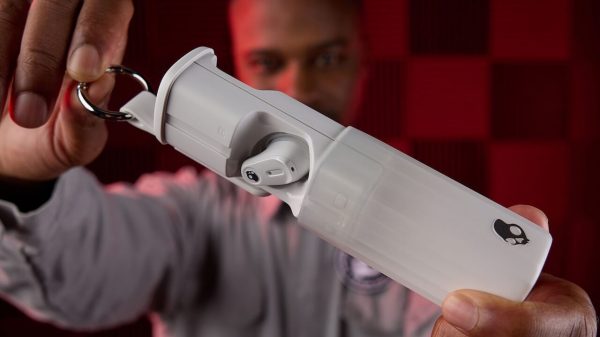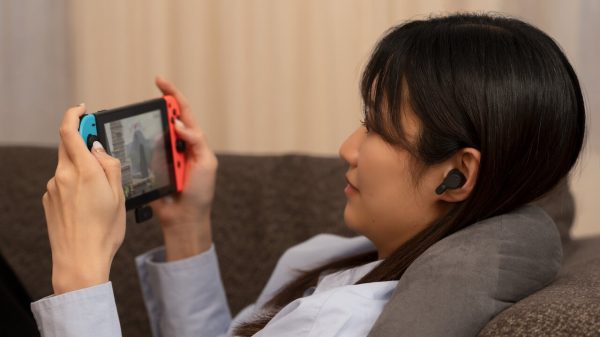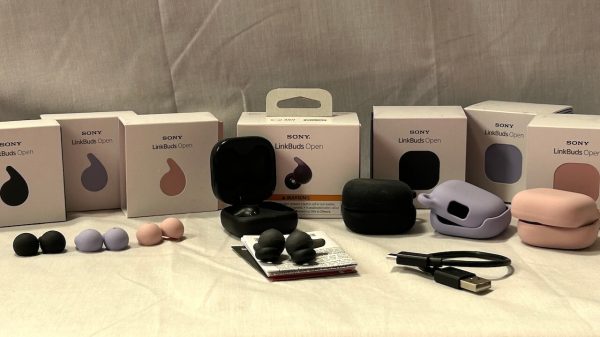OnePlus started out making budget smartphones and their current 9 Pro and 10 models rival the best flagships in the industry. Likewise, they started developing earbuds to go with their phones a few years ago and recently released their newest flagship model; the OnePlus Buds Pro.
These are designed to be a direct competitor to Apple’s AirPods Pro and Samsung’s Galaxy Buds Pro. It has become a trend that phones are being bundled with high-end true wireless earbuds; for some it was a liability to not offer a package to consumers.

The OnePlus Buds Pro are easily their most polished offering to date and the $150 retail price reflects that. When compared to the Apple AirPods Pro or Samsung Galaxy Buds Pro, the price is not out of line as long as the feature set and sound quality hold up to the same standards.
The package is pretty standard with the earpieces, case, three sets of silicone tips, and a USB Type-A to Type-C charging cable that is entirely too short to be of much use; something that become a trend in the industry and it really doesn’t make a lot of sense.
The buds themselves take their design cues from the AirPods Pro with a similar size and shape and my pair are even the same shade of white polymer on the upper portion of the bud.

The OnePlus does use a polished metal stem that acts as the touch sensor on both earpieces that helps to distinguish it from the Apple product and the OnePlus is also offered in black for those that want a little more differentiation.
The Skinny
The buds have an almost globe like body that fits in the ear well for me but may present an issue for smaller ears. The nozzles are short with a slight forward rake and an ovoid shape that may make the use of third party tips a bit more difficult.
I found that SpinFit tips fit well and stayed in place well while a couple others I tried were loose enough that I didn’t feel comfortable putting the buds on and finding out the tip was not going to stay in place.

If you are using third party tips, try them first so you don’t have issues. I am told that OnePlus will be offering replacement tip sets as well, so the need for third party accessories may not be an issue.
The stems are just under two centimeters in length and fit comfortably in the intertragal notch; the touch sensors work well which is a huge point in their favor after fiddling with far too many TWS models where a 1mm difference in contact point either changed the function or failed to do anything.
The case fits in a pocket easily with its rounded edges making it more comfortable than some to carry that way. The supplied charging case has a USB Type-C port on the rear and a single button inside the case in the center front for pairing the buds.

A single LED is visible on the front of the case just below the hinge and is used to show both charge state and connection/pairing state when opened. A paired device will show green while a pairing state flashes white. The LED also illuminates to indicate wireless charging at least when the case is first placed on the charge pad.
The buds are IP55 rated and should be good for outdoor and gym use; although I would avoid the pool. The case is only IPX4 rated and it is best to avoid water around it altogether.
After inspecting the buds and accessories, I dutifully charged them overnight since the manual suggested a full charge before trying to use them. The next morning upon opening the case, I was greeted by a Google quick pair prompt on my phone offering to pair the buds.
I accepted the offer and off we went. I checked the codec to see what was in use and it showed it had paired using AAC on my S21 and iPhone, but the OnePlus 9 sent with the buds paired using the new LHDC codec.

LHDC is supposed to be baked into the next major release of Android so it may be that we will start seeing support on devices like the S21 in the near future as updates are released which would make the buds an even better option with other phones.
If you are used to the controls on the AirPods Pro, you’ll be right at home with the OnePlus as the controls are identical down to the auditory prompt when a touch is registered.
A single pinch pauses or restarts, twice skips to the next, three times goes back a track, and pinch and hold switches between ANC and ambient modes. I do wish that on ANC/Ambient mode that it had more feedback than the little bell to tell you which state you were in. For that function, the Hey Melody app is easier to use than the onboard controls.
The app offers some interesting features, but also lacks some fairly common ones. It does provide a battery meter for both the buds and case, and the ability to switch between standard, noise cancelling and ambient modes.
In ANC mode, you have the choice of three levels of noise cancelling and the difference in levels is rather audible. The ANC does work well with constant noises and does its best with lower frequencies.
Midrange and high frequency noise have a tendency to break through the ANC. Unfortunately, the Extreme ANC also can be heard as a bit of a veil when listening so is probably best tuned back to smart unless absolutely required.
The app does offer an AudioID test that allows you to tune the earbuds to your hearing. Unfortunately, it does this by playing a series of tones and asking the user to respond yes or no if they heard each tone. While this does allow tuning when compared to a more conventional equalizer, it is much more of a guessing game.
Other app features include a fit test to help determine tip size and a firmware update option. A dual connection option exists as well so the buds can be paired with two devices and then switched between them.

The only issue I see here is you need device 1 (the primary) to tell the buds to switch to the secondary device, so you’ll likely need to have both devices handy.
Sound
The OnePlus Buds Pro use an 11mm dynamic driver that OnePlus advertises as “Tuned for bass reproduction” but thankfully that doesn’t mean that is all it delivers and bass heads probably won’t be overly pleased as the bass elevation is actually fairly mild and doesn’t obscure other elements as it drops back rapidly above the sub bass.
The sub bass does have a mild emphasis and give the music good drive, but the mid bass falls back with the rest of the signature, and while it has enough presence to sound natural, it lacks enough emphasis to become the focal point.
The midrange tuning is a bit different than some where the scoop is in the lower midrange.
This gives male vocals good presence and guitar a little more emphasis in its lower registers while keeping the upper registers a bit lean. To my ears, this is a bit more natural and organic sounding than the typical lower midrange trough.
The downside to the trough being where it is, is that piano and strings lack the energy they need to sound fully whole and the bud is better with some genres than others as a result.
There is a mild forward push in the upper midrange that lifts female vocals and keeps strings from sounding too lifeless which does help, but not enough to fully correct the dip.
The treble stays on the same plane with the upper midrange which gives the OnePlus a nice open top end with enough air to keep from sounding too closed in and roll-off is somewhere above 15kHz which gives the OnePlus enough room to work.
Those looking for a highly detailed sounding pair of wireless earbuds will be slightly disappointed, but that is pretty common with ANC earbuds.
The soundstage is limited as well, which is also a common issue due to size and the sealed nature of ANC designs.
Sonically, the OnePlus Buds Pro compete on an even footing with products like Samsung’s Galaxy Buds 2, Apple’s AirPods Pro, and Amazon’s Echo Buds 2, and were a bit better than Google Pixel Buds in my experience.
The battery life was roughly seven hours without ANC in use and dropped to roughly five hours with it turned on, which means that their stated numbers are about right and they didn’t exaggerate as much as some (Amazon) at least on the buds themselves.
I found the estimates on the case somewhat exaggerated; their claim of almost five full charges when in my experience it is closer to almost four full charges is definitely different. Most people won’t complain about that but it was definitely worth noting.
Phone call quality was average; it was definitely on par with its competition but if you use these types of wireless earbuds for making calls, don’t expect an experience that is superior to the AirPods Pro or Samsung models.
Other features like game mode and Dolby Atmos listed in the ad copy are only available if paired with a OnePlus Phone and to my mind are more a feature of the phone than the earphones If you have a OnePlus Model 9 or 10 phone (the only ones supported) these features become more relevant, but I can’t see buying a phone to be able to use them.

Conclusion
Overall, the OnePlus Buds Pro are easily their best effort to date and turned in a strong performance. Those who get the buds with a phone package shouldn’t feel they got slighted compared to those buying Apple, Samsung or Google Phone/Bud packages.
When looking at the buds alone though, the decision is made a bit harder by the fact that while the OnePlus does have a solid feature set, they are far from alone in the market, and with the lack of EQ, some features being available only with a OnePlus Phone, and the price being roughly equal with bigger brands, they do have some weaknesses to overcome.
The OnePlus Buds Pro compare well against the biggest names in the market so they are well worth a look. I’ve seen them discounted to $120 that makes them a stronger choice than their $150 sticker price; if they ever go on sale at $99 — I would strongly consider buying them.
Where to buy: $149.99 at Amazon | Oneplus.com
Related reading: Best Earbuds and Headphones





































